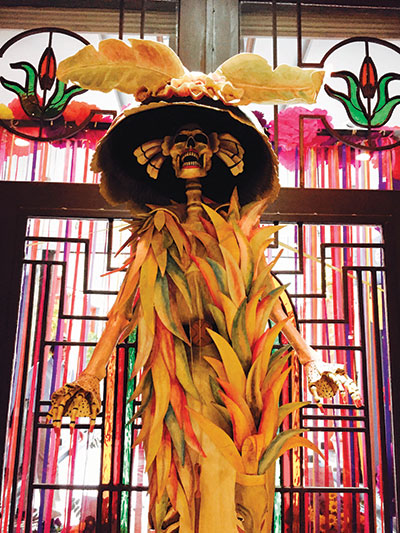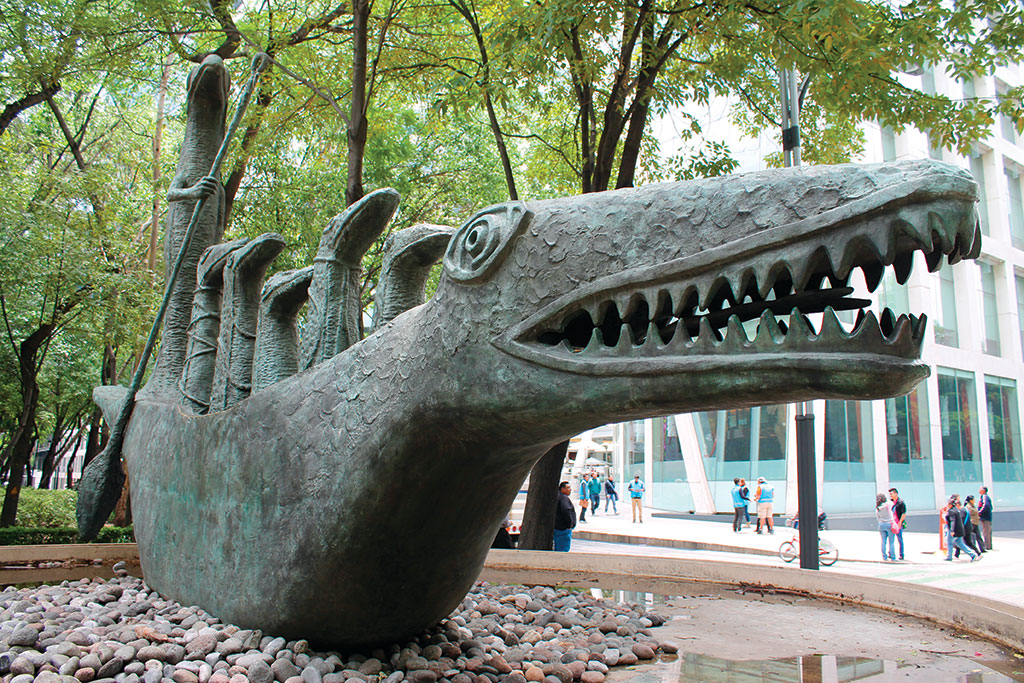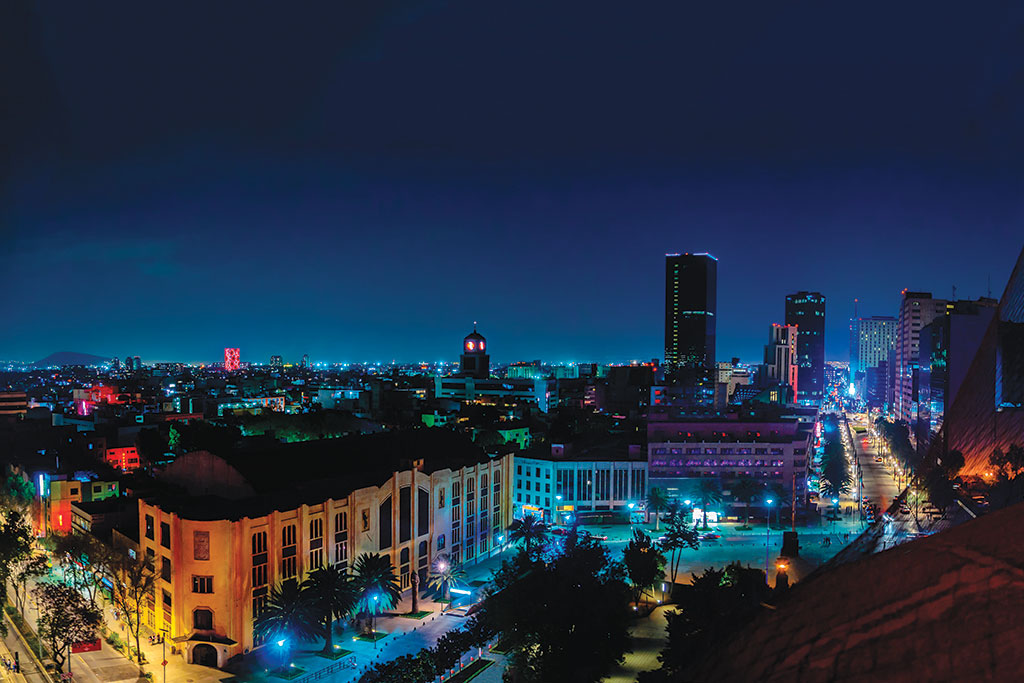She reaches for the sky, high above the congested Mexico City streets. Holding up a laurel crown for the people who sacrificed for the Mexican Revolution. Her gold flickers in the afternoon sky—standing tall as a symbol of triumph, life, and hope for the Mexican people as her ascension into heaven is immortalized.
Below the Angel of Independence, the circular artery of the city is busy celebrating death. “Click clack, click clack,” a man shouts through his black-and-white skeletal makeup, gesticulating wildly like a spider. Catrinas twirl in the shadows of the angel, spinning like color wheels from the bright fabrics that comprise their dresses. Children dolled up like pumpkins and witches forage for sugar skulls and chocolates on the streets. Teenagers howl with excitement passing the street vendors nearly covered by piles of bright tropical produce. A drag queen sneakily sips Presidente beer, and she grabs fuego from a vendor to light a loosey cigarette she just bought. A puff of smoke covers her painted face replete with plastic Halloween-store bugs meticulously glued into place.

Day of the Dead Parade in Mexico City
“This one is ours,” a dreadlocked punk girl says munching on cut mango with tajin peppered like ants on the fruit’s bright-orange flesh pointing to an alabrije. Here, on the Paseo de la Reform, among the crowd are hundreds of life-size paper-mache Lovecraftian “creatures”— each more fantastical than the next with vibrant colors that bring life to the sculptures and smiles to the passersby.
In the center of Mexico City, below an angel, are the people of this divine capital celebrating death by embracing life. It’s a parade of culture and traditions. Aztec stories swirl with Roman Catholic ideologies and turn-of-the-century artists’ imaginations are reimagined by modern-day artists who have all come together to create Mexico City’s firstever Dia de Los Muertos parade.
This parade, this cacophony of life and death, has never existed in Mexico City. It wasn’t until 2015’s James Bond Spectre that Mexico City entertained the idea of holding a parade to celebrate the age-old tradition of Dia de los Muertos. The opening scene shows Daniel Craig chasing someone through the city streets while a parade causes chaos (and creates a gorgeous backdrop). The movie had enough people asking Mexicans about the parade, that didn’t exist, for Ciudad de Mexico to create one.
And while some locals feel the parade is commercializing and cheapening the importance of this holiday, others point out the uniqueness. “It is the perfect example of modern Mexico,” local Ricardo Piqué tells me. “We have the skeletons, the fruit, the offerings from very old traditions. We have Catrina and the Alabrije that are only recent additions to the zeitgeist thanks to artists from the early 20th century. And we have this all blended together thanks to a movie from the 2000s.”
The parade, like Mexico City itself, is an amalgamation of this land’s proud pre-Hispanic history, but also of our cosmopolitan modern world. From Aztec ruins hidden under grand plazas to Spanish palaces serving as modern-art galleries, whistling street vendors selling fresh camotes to Michelin-starred restaurants, this metropolis is rife with experiences that are decidedly Mexico City.


Catrina in Hotel Parque Mexico
Mexico City can appear overwhelming with its population of nearly nine million and hundreds of neighborhoods; first-time visitors should look into hiring a guide. While it’s not my first time here, I choose to seek the help of a gay-friendly in-the-know man to show me new aspects of this always-changing place. Antonio Suarez from Toursbylocals.com is eager to take me around his city.
I’m staying at an historic property called Hotel Geneve that’s located right in the gay-centric district of Zona Rosa. The building is a belle époque marvel, so take time to admire the lobby even if you’re not stay- ing here, and grab a cocktail at the Phone Bar, inspired by Winston Churchill’s visit here. Unfortunately, the rooms are quite small, limited by this grand dame’s original layout, but that’s easily forgiven when you find yourself within walking distance to the excitement of Zona Rosa.
“Zona Rosa didn’t always look like this,” Antonio tells me as he points to the hodgepodge and not-so-appealing architecture that lines the tributary streets that lead to the pedestrian-only Genova Street. “The earthquake of 1985 took a major toll on the city, but especially Zona Rosa. It was once home to wealthy people who wanted to escape downtown.” With the loss of historic buildings, the rebuilding of the area organically happened, aka, without planning. The LGBT community almost immediately took advantage of the area’s decline. According to Antonio, the first LGBT bar to open was called El Taller (The Workshop) in 1987. Located in a basement, it was one of the first true places for the community to gather without fear. Its opening served as a harbinger for the city’s and country’s first gayborhoods.
In its prime, nearly 100 LGBT establishments existed, but this number has been declining. “Everything is starting to spread out all over the city,” Antonio says. Many in the local LGBT community shy away from the tourist-heavy LGBT bars of Zona Rosa, instead choosing more local haunts.
Today, the area is still the epicenter of the Marcha del Orgullo Lésbico, Gay, Bisexual, Transgénero, Travesti, Transsexual, e Intersexual (gay pride), and a fun place for tourists to bar hop. Visit Nicho Bears for a low-key bear night where you’re assigned numbers for secret messages; Teatro BB Show for wild performances in a trendier environment; and BoyBar where I awkwardly order beers alone and watch two men shower together in the middle of the floor.


“Cocodrilo” by Leonora Carrington
During my recent visit, I meet up with an old friend, Saúl Lomelí Guerrero, who moved from his hometown of Guadalajara to Mexico City where he began his own PR company. Stylish, wearing a full-length camo jacket, tortoise-shell glasses, and a properly quaffed mustache, he leads me through the streets of Mexico City’s most desirable colonia, Polanco. It’s midday and men and women are finely dressed, sitting in the comfortable weather, dining on lavish meals. It’s a strange sight to see so many people out enjoying themselves over bottles of wine and multi-course meals during a work day. Lincoln Park stretch- es a few blocks with buskers, sculptures (including a beautiful sculpture of Abraham Lincoln), and shady corners to relax. We also cross a street named after Irish LGBT icon Oscar Wilde.
He takes me to a curated shop that nicely shows off the city’s eclectic style. Common People is three floors of hand-picked clothes and accessories that totally speak to those looking to make a statement with their outfits. Rooms are divided by theme, from beach-ware to outrageous concept outfits, and it’s sure to provide some inspiration.
Bags in hand, we pass high-end designer shops like John Varvatos, Gucci, Hermès, and Louis Vuitton, and hit up Lust, another concept shop that’s filled with rare sneakers. Surprisingly, Americans will still find the prices to be a little less than in the US, thanks to the exchange.
Sitting down at Nexo Wine Bistrot, we have a chance to talk over delicious Mexican wines and charcuterie. “Mexico City is more cosmopolitan than ever, with always-opening restaurants, street art, and noisy markets. What I love now, after six years living here is that I have learned that life is always changing,” he tells me as we watch the chicly dressed men and women returning to work. “I’ve learned about change, growing with the change, and accepting the change. This could be both politically, socially, and structurally. Yes, Mexico City is the fastest changing place I have ever lived, always in a rush.” Inevitably the conversation leads to Donald Trump, and we laugh, sipping our wines, in the shadows of million-dollar apartments and five-star hotels. “Build a wall, what for?” we joke.


